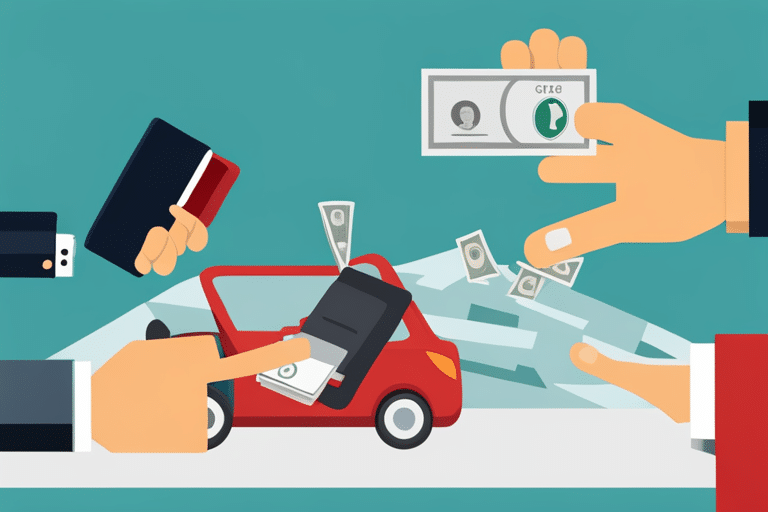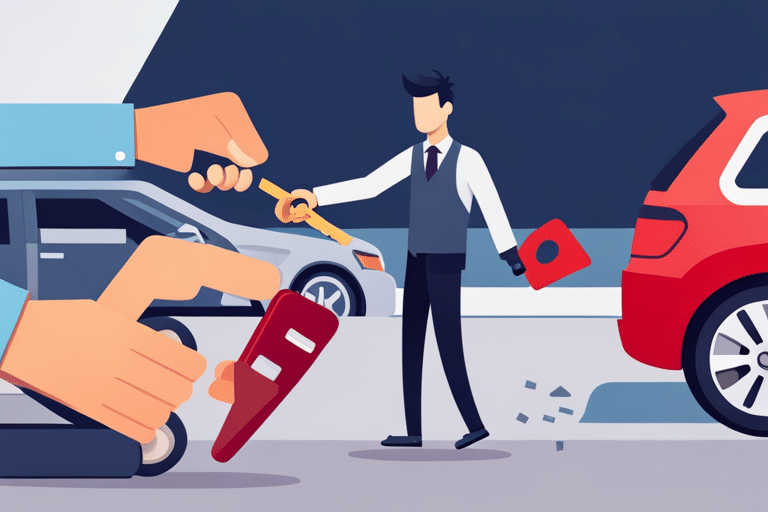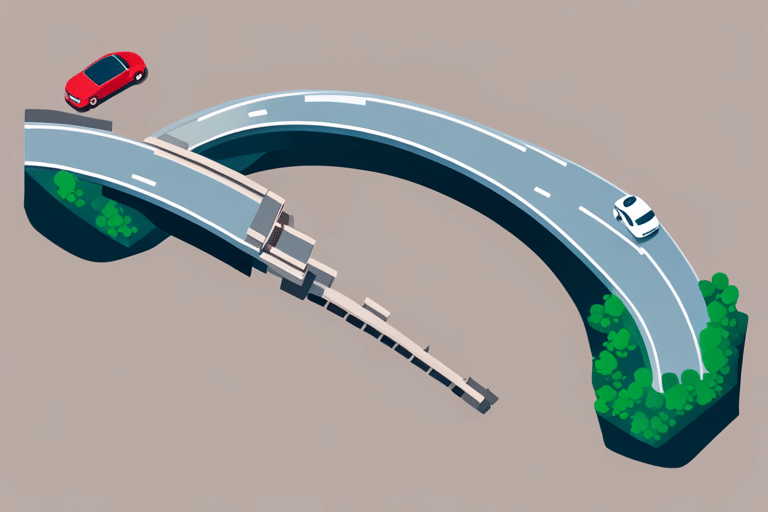Imagine you’re driving down the open road, wind in your hair and a smile on your face. But suddenly, bam! You find yourself in an accident.
Now, picture this: you have to pay a certain amount before your insurance kicks in. Confusing? Don’t worry!
In this article, we’ll break down deductibles and show you how they impact your auto insurance. Get ready to decode the mysteries of deductibles and become a master of your own coverage!
Key Takeaways
- Deductibles play a crucial role in auto insurance, as they determine the amount that policyholders must pay out of pocket before their coverage kicks in.
- Choosing a higher deductible can result in lower monthly premiums, but it also means higher out-of-pocket expenses in the event of a claim.
- Factors such as driving history, car value, and personal financial situation influence the deductible amount assigned by insurers.
- Finding the right balance between deductible amount and coverage limits is important, as higher deductibles lead to lower premiums but also increase financial responsibility.
Understanding Deductibles: A Key Component of Auto Insurance

Understanding deductibles is crucial when it comes to comprehending the ins and outs of auto insurance. Think of them as the secret ingredients in your insurance policy, adding a dash of complexity and a pinch of confusion. But fear not, dear reader! We’re here to guide you through this whimsical world of deductibles.
Let’s start with deductible options. Imagine you’re at an ice cream parlor (because who doesn’t love ice cream?). You have two choices: vanilla or chocolate. Similarly, auto insurance offers different deductible options for you to choose from. You can pick a low deductible, like vanilla, which means you’ll pay less out-of-pocket if you make a claim but might have higher premiums. Or you can go for a high deductible, like chocolate, where your out-of-pocket expenses will be higher but your premiums lower.
Now that we’ve covered the options, let’s dig into the factors that determine your deductible amount. Just like finding the perfect scoop of ice cream depends on various factors – flavor preference, portion size – determining your deductible involves considering things like your driving history, car value, and personal financial situation.
So there you have it – a taste of what understanding deductibles entails! Now that we’ve satisfied our sweet tooth with these delightful explanations about deductible options and factors influencing them, let’s move on to the basics: What are deductibles and how do they work? Get ready for more delicious knowledge coming right up!
Transitioning smoothly into our next section – let’s dive deeper into the basics: what are deductibles and how do they work?
The Basics: What Are Deductibles and How Do They Work

So you’ve got your auto insurance policy all sorted out, but now it’s time to tackle the dreaded deductible. Don’t worry, we’re here to break it down for you in the most delightful way possible!
Let’s start by unraveling the mystery of different deductible amounts and then dive into the pros and cons of having one.
Get ready for a whimsical journey through the world of deductibles!
Different Deductible Amounts Explained
To fully grasp the concept of different deductible amounts, you’ll need to understand how they impact your auto insurance coverage. Think of deductibles as a magical door to savings. The higher your deductible, the lower your monthly premium. But beware! If you find yourself in an accident and need to make a claim, you’ll have to pay more out of pocket before your insurance kicks in. It’s like choosing between a small gnome guarding a treasure chest or a mighty dragon protecting it – both have their pros and cons. To help you decide which deductible option is right for you, take a look at this whimsical table:
| Deductible Amount | Monthly Premium | Out-of-Pocket Expense |
|---|---|---|
| $500 | $100 | $500 |
| $1,000 | $80 | $1,000 |
| $2,000 | $60 | $2,000 |
Pros and Cons of Deductibles
When choosing between different deductible amounts, weigh the pros and cons to find the right balance for you.
Let’s take a whimsical journey into the world of deductibles, shall we? Picture this: you’re driving down a winding road, wind in your hair, when BAM! You accidentally hit a parked car. Now comes the moment of truth – how much will it cost you? Here’s where deductibles come into play.
The pros? A higher deductible means lower monthly premiums. It’s like getting a discount on your insurance bill!
But beware, my friend, because there are cons too. Opting for a high deductible means more money out of pocket if you have to file a claim. So consider your budget and risk tolerance before making that decision.
Speaking of decisions, let’s delve deeper into the factors that impact deductibles and insurance premiums.
Transition: Now that you know about the pros and cons of deductibles, let’s explore the various factors that can influence these crucial numbers in your auto insurance policy.
Factors That Impact Deductibles and Insurance Premiums

If you choose a higher deductible, your insurance premiums will generally be lower.
But wait, what exactly is a deductible? It’s like the secret handshake between you and your insurance company. When you file a claim for that fender bender or rogue shopping cart incident, the deductible is the amount of money you have to pay before your insurance kicks in.
So, let’s dive into the factors that can affect how much you’ll have to shell out.
First up, we have your driving record. If you’re a regular speed demon or have a knack for turning red lights into suggestions, insurers might see you as more of a risk-taker. This could mean they’ll assign you a higher deductible to offset their potential payout if things go awry.
Next on our list is the type of coverage and coverage limits. If you opt for full coverage with high limits, chances are your insurer will want to protect themselves from hefty payouts by assigning you a higher deductible. On the other hand, if you’re okay with basic coverage and lower limits, they may be more lenient with deductibles.
Your car’s value also comes into play here. If it’s an expensive luxury ride that would make James Bond jealous, expect to see higher deductibles attached to it. Insurers want to make sure they’re not on the hook for major repairs or replacements.
Now that we’ve uncovered these factors affecting deductible amounts, let’s talk about how deductibles impact coverage limits. Basically, choosing a higher deductible means taking on more financial responsibility upfront when something goes wrong. But in return, your premiums get some much-needed rest and relaxation at a lower rate.
Choosing the Right Deductible Amount: Balancing Risk and Cost

Choosing the right deductible amount is all about finding a balance between managing risk and keeping costs in check. It’s like walking on a tightrope, where one misstep can send you tumbling into financial chaos or leave you paying higher premiums than necessary. But fear not, for I am here to guide you through this delicate dance of balancing risk and cost effectiveness.
Picture this: on one side of the scale, we have a high deductible. This means that if catastrophe strikes, you’ll have to fork over a hefty chunk of change before your insurance kicks in. On the other side of the scale, we have a low deductible. This means that your out-of-pocket expenses will be lower when something goes awry, but your monthly premium will likely be higher.
To help you visualize this delicate balancing act, here’s a handy table:
| High Deductible | Low Deductible |
|---|---|
| Lower Premiums | Higher Premiums |
| More Risk | Less Risk |
| Cost-effective | Expensive |
| Budget-friendly | Peace of mind |
| Financial gamble | Safety net |
Now that you’ve seen it laid out before you, it’s time to make an informed decision. Consider your budget and how much risk you’re willing to take on. Are you comfortable with paying less upfront but potentially facing higher costs down the road? Or would peace of mind in knowing that most incidents won’t break the bank outweigh the slightly higher premiums?
The Relationship Between Deductibles and Coverage Limits

The relationship between deductibles and coverage limits can greatly affect the overall cost of your insurance. It’s like a dance, where the deductible amount and coverage limits twirl around each other, determining the final price you pay for your auto insurance. Let’s take a closer look at how this dynamic duo can sway your wallet:
- On one side of the ballroom, we have deductible amounts:
- Higher deductibles can lead to lower premiums. Imagine doing a fancy tango with a higher deductible. Yes, you’ll have to pay more out of pocket if you make a claim, but in return, your monthly premium might be lower. It’s all about finding that balance between risk and reward.
- Lower deductibles mean less financial stress. If dancing on the edge isn’t your style, then stick with a lower deductible. Sure, it may come with slightly higher premiums, but when life throws unexpected twists and turns at you (like a fender bender), you won’t have to worry about breaking the bank.
Now that we’ve covered the dazzling world of deductibles and their impact on costs, let’s move on to another key topic: comprehensive coverage. This type of coverage is like having an umbrella for those rainy days when accidents happen outside of collisions. So grab your raincoat because we’re diving into ‘deductibles and comprehensive coverage: what you need to know’.
Deductibles and Comprehensive Coverage: What You Need to Know

Now let’s dive into what you need to know about deductibles and comprehensive coverage.
Picture this: you’re driving down a winding road, the wind in your hair, and suddenly, bam! A rogue squirrel darts out in front of you, causing you to swerve and hit a tree. Ouch! But fear not, my friend, because that’s where comprehensive coverage comes to the rescue.
Comprehensive coverage is like having a superhero cape for your car. It protects you against those unexpected accidents that are beyond your control – think theft, vandalism, or even damage from natural disasters. But here’s the catch: just like any superhero costume needs an accessory (come on Batman, where would you be without your utility belt?), comprehensive coverage also has its own companion – the deductible.
Deductible limits are essentially the amount of money you have to pay out of pocket before your insurance kicks in. It’s like paying for popcorn at the movies before watching the action unfold on screen. Now here’s where it gets interesting – you have some say in choosing your deductible limits. The higher your deductible, the lower your premium will be (aka less money coming out of your wallet each month), but remember that if something happens to your car, you’ll need to cough up more cash upfront.
But don’t fret! There are alternatives to traditional comprehensive coverage with fixed deductibles. Some insurance companies offer options such as disappearing deductibles or zero-deductible plans. These can give you more flexibility when it comes to covering those unexpected expenses.
Collision Coverage and Deductibles: Exploring the Connection

Let’s dive into how collision coverage and deductibles work together to protect your car. It’s like a dynamic duo, fighting off the evil forces of fender benders and dings. With collision coverage, you’re covered for those unfortunate moments when your car collides with another object or vehicle. But what about deductibles?
Well, they’re like the sidekick to collision coverage, helping determine how much you’ll have to pay out of pocket before your insurance kicks in. It’s all about finding that perfect balance between protection and cost.
Now, let’s explore some alternatives to understand this connection even better:
- Alternative 1: The Low Deductible Path
- Picture yourself driving down the road with peace of mind knowing that if anything happens, your deductible is low.
-
Feel the warmth of security as you know that even if a mishap occurs, it won’t break the bank.
-
Alternative 2: The High Deductible Route
- Imagine taking a leap and choosing a higher deductible option.
- Sense the thrill of potentially lower premiums while still having solid protection in case of an accident.
When it comes to collision coverage explained, it’s important to consider these alternatives and choose what works best for you. Whether you prefer lower monthly payments or want maximum protection without worrying about high costs, there are options out there waiting to be explored.
Is a High Deductible Right for You? Pros and Cons to Consider

Consider whether a high deductible would be the right choice for you by weighing the pros and cons. When it comes to insurance, there are always decisions to be made. One of the biggest choices you’ll face is whether to go with a high deductible or a low deductible. It’s like choosing between a daredevil roller coaster or a gentle carousel ride at the amusement park of insurance options.
To help you make an informed decision, let’s break down the pros and cons in a whimsical table that will evoke emotions and spark your mastery over deductibles:
| High Deductible | Low Deductible |
|---|---|
| 🎢 Thrilling risk-taker | 🎠 Safe and steady |
| 💰 Lower premium | 💸 Higher premium |
| 🌈 Potential savings if accident-free | ☔️ Peace of mind regardless |
Now, let’s dive into each column! If you’re feeling adventurous and want to save some money on your monthly premiums, then a high deductible might be just what you need. Think of it as hopping onto that daring roller coaster – it may give you an adrenaline rush, but if you stay accident-free, those potential savings can make it all worthwhile.
On the other hand, if peace of mind is your top priority and budgeting for unexpected expenses isn’t your cup of tea, then go ahead and choose the safety of a low deductible. It’s like enjoying a leisurely ride on the carousel – no surprises or sudden drops here!
Ultimately, when deciding between a high or low deductible, consider your risk tolerance level, financial situation, and overall preferences. Remember that both options have their merits; it’s just about finding what suits you best.
The Claim Process: How Deductibles Come Into Play

When filing a claim, it’s important to understand how deductibles factor into the process. Think of deductibles as magical creatures that can either make your insurance coverage soar or plummet. Here’s a whimsical guide to help you navigate the claim process and decode how deductibles come into play:
- The Good Goblins:
- Deductibles can lower your monthly premium, which means more gold in your pocket!
-
They serve as a safety net for insurers, ensuring that not every tiny scrape and bump will lead to a claim.
-
The Mischievous Pixies:
- High deductibles can be like pesky little sprites, requiring you to pay more out of pocket before your insurance kicks in.
- If you choose a low deductible, those mischievous pixies might raise your monthly premium, leaving you with less treasure each month.
Navigating the claims process is like stepping into an enchanted forest. When you file a claim, your insurer will subtract the deductible amount from what they owe you. So if Frodo the Hobbit accidentally crashes his wagon and the damage amounts to $1,000 with a $500 deductible, his insurer will only cover $500.
Understanding this impact on coverage is vital when choosing your deductible amount. Keep in mind that higher deductibles could mean more money upfront if an accident occurs but lower monthly premiums overall. It’s all about finding that balance between protecting yourself financially and having enough coins left for adventures.
And now that we’ve explored how deductibles factor into the claims process, let’s dive deeper into their long-term impact on your insurance rates…
Deductibles and Your Insurance Rates: The Long-Term Impact

Understanding how deductibles affect your monthly premiums is crucial for making informed decisions about your coverage. It’s like finding the perfect balance between eating enough pizza to satisfy your cravings, but not too much that you end up with a food coma. Just like pizza, insurance policies come with different deductible options, and choosing the right one can have a long-term impact on your wallet.
When it comes to deductibles and credit scores, think of it as a dance-off between two unlikely partners. Your credit score does influence your insurance rates, but luckily, deductibles don’t play a major role in this tango. So don’t worry if you’re not rocking an A+ credit score; you can still find affordable coverage by focusing on other factors.
Speaking of factors, understanding how they affect your deductibles is like solving a puzzle where all the pieces need to fit perfectly. The type of car you drive and where you live are just some of the elements insurers consider when determining deductible amounts. Remember that higher deductible means lower premiums – so if you’re confident in your driving skills and want to save some cash each month, opting for a higher deductible could be the way to go.
Now that you’ve mastered the art of understanding how deductibles impact your rates, let’s move on to the next chapter: deductibles and insurance discounts – maximizing your savings. After all, who doesn’t love getting a discount? We’ll explore ways to minimize those out-of-pocket expenses while still maintaining comprehensive coverage. So buckle up because we’re about to take saving money on auto insurance to a whole new level!
Deductibles and Insurance Discounts: Maximizing Your Savings

Get ready to save big on your coverage by taking advantage of insurance discounts and maximizing your savings. Who doesn’t love saving money, right? Well, when it comes to auto insurance, there are plenty of ways you can earn those sweet discounts and keep more cash in your pocket. Let’s dive into the world of deductibles and explore how they can impact your insurance rates.
When it comes to safe driving, insurers reward those who have a clean record with lower premiums. By maintaining a spotless driving history, you not only avoid accidents (which is always a good thing), but you also qualify for some serious discounts. So put on that seatbelt, use those turn signals, and show the road who’s boss!
Now let’s talk about vehicle type – because what you drive matters too! Insurers take into account the make, model, and year of your car when calculating potential savings. If you’re cruising around in a safer vehicle with advanced safety features like anti-lock brakes or airbags galore, you’ll likely be eligible for some fantastic discounts.
So there you have it – two key factors that can lead to massive savings on your auto insurance premiums: safe driving habits and owning a safer vehicle. But don’t worry if these seem out of reach right now – in the next section we’ll give you some tips for managing deductibles and making informed insurance decisions.
Tips for Managing Deductibles and Making Informed Insurance Decisions

So, you’ve finally decided to take charge of your insurance and make informed decisions – bravo! Now, let’s talk about choosing deductible amounts and the impact they have on those pesky premium costs.
Don’t worry, we’ll break it down for you in a way that won’t make your head spin. Grab a cup of tea, get cozy, and let’s dive into this deductibles and premiums rollercoaster together!
Choosing Deductible Amounts
When it comes to choosing deductible amounts for your auto insurance, it’s important to consider your budget and potential savings. So, let’s dive into the world of deductibles and explore all the options you have! Here are a couple of things to keep in mind when evaluating risk and deciding on a deductible:
- Deductible Options:
- Low Deductible: If you want peace of mind knowing that you won’t have to shell out much cash after an accident, this is for you.
- High Deductible: Embrace some adventure! You’ll pay less upfront but be prepared for a higher bill if something goes wrong.
Now, I know evaluating risk can be daunting, but don’t worry! Trust yourself and choose what feels right for your circumstances. Once you’ve made your decision, brace yourself because the next section will take us on a thrilling ride through the impact these deductible choices have on premium costs. Get ready!
[Transition Sentence] But first, let’s see how these deductible amounts can affect your wallet.
Impact on Premium Costs
But before we dive into the impact on premium costs, let’s take a look at how these deductible amounts can affect your wallet.
Picture this: you’re cruising down the road in your shiny car, feeling like a master of the universe. Suddenly, bam! A rogue squirrel darts out and you’re left with a dent or two.
Now, here comes the fun part – deductible options! You have the power to choose how much you’re willing to pay out of pocket before your insurance kicks in. The higher your deductible, the lower your premium will be. It’s like a secret code for saving money!
Frequently Asked Questions
Are There Any Exceptions Where a Deductible May Not Apply?
In some cases, you might luck out and not have to pay a deductible. Like when you hit a deer or it’s not your fault. But don’t get too excited, exceptions are rare!
Can I Change My Deductible Amount After Purchasing My Auto Insurance Policy?
Sure, you can totally change your deductible amount after buying your auto insurance policy! It’s like switching up your toppings on a pizza. Just talk to your insurance provider about the different deductible options available. Easy peasy!
How Does the Type of Vehicle I Drive Affect My Deductible?
The type of vehicle you drive can have a big impact on your deductible. Factors like the car’s value, safety features, and repair costs all play a role in determining how much you’ll have to pay out-of-pocket if an accident occurs.
Is There a Maximum Deductible Amount That I Can Choose?
Yes, there is a maximum deductible amount you can choose for your auto insurance. However, keep in mind that there may be deductible exceptions based on your policy and specific circumstances. Stay informed!
Can My Deductible Be Waived if I Am Not at Fault in an Accident?
If someone else is at fault in an accident, your deductible can sometimes be waived. This is one of the exceptions to the deductible requirement. It’s like getting a free pass!
Conclusion
So there you have it, dear reader! The world of deductibles in auto insurance has been decoded just for you.
Now that you understand how they work and the impact they can have on your policy, you’re equipped to make informed decisions.
Remember, finding the right balance between risk and cost is key when choosing a deductible amount. And don’t forget to keep an eye out for insurance discounts that can help maximize your savings!
Happy driving and may your deductibles be as low as a limbo champion’s bar!

